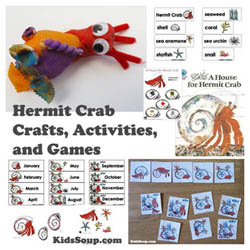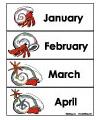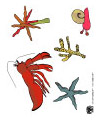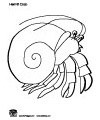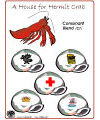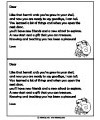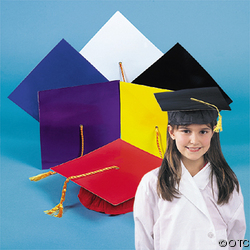Graduation Literacy Activity
A House for Hermit Crab
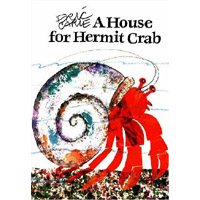
Objectives
Children will make predictions about a story.
Children will listen to a simple short story.
Children will recall details from a simple short story.
Materials
- Book: A House for Hermit Crab
Directions:
A House for Hermit Crab by Eric Carle is great way to help children transition from preschool to kindergarten or from kindergarten to first grade.
Book description: One day Hermit Crab discovers that he has outgrown his shell. He is frightened and moves into another shell but thinks that it looks too plain. So, each month he finds a new friend to live with him. Eventually, Hermit Crab outgrows his shell and must find an even bigger shell to make his home. He is reluctant to leave his new friends but finally does, and a little hermit crab, who promises to be good to Hermit Crab’s friends, moves into the shell. Hermit Crab finds a bigger shell in which to reside, but this time he isn’t afraid. He knows that he can make new friends.
Literacy Activity:
The name of this book is A House for Hermit Crab. It is written by Eric Carle. Let’s look at the cover. What do you think this book is going to be about? Give children an opportunity to respond. Let’s find out. Read the book to children. After reading the book, retell the story, asking questions along the way.
One day in January, Hermit Crab realized that he had outgrown his shell. He said, "I've grown too big for his little shell." What did Hermit Crab decide to do? Let children respond. Yes, he decided to move out of his shell, but he was afraid. Who was he afraid of? Let children respond. That's right, Hermit Crab was afraid that a big fish might attack him. What happens next in the story? Let children respond. Very good. In February, Hermit Crab found a bigger shell to move into, but he thought it looked too plain. What does Hermit Crab do so that his shell doesn't look plain anymore? Let children respond. Discuss with children what happens during the months April through October. (Hermit Crab meets and invites an anemone, a sea star, a coral, a snail, a sea urchin, a lantern fish, and some pebbles to live with him.) In November, Hermit Crab realizes that his shell has gotten too small because he had been growing little by little throughout the year. What did Hermit Crab need to do? Let children respond.Yes, Hermit Crab decides that he needs to find a new home, but he doesn't want to leave his friends. In December, Hermit Crab meets a little hermit crab who needs a new home. Before the little hermit crab moves into Hermit Crab's house, what did the little crab promise to do? Let children respond. That's right! The little crab promised to be good to Hermit Crab's friends. So in January, the little crab moved into Hermit Crab's home and Hermit Crab found a new, bigger shell to live in. Was Hermit Crab afraid? Let children respond. Very good. Hermit was not afraid. He was thinking about all the new friends he could make!
Talk with children about how just like Hermit Crab, they have grown throughout the year. They have gotten bigger, they have learned new things, and they have made many new friends. And just like Hermit Crab, they have outgrwon their "shell." They are ready to move on to learn more new things and to make more new friends.
Extensions:
Movement:
Show children pictures depicting the various animals in the book. First, talk about the animal. (For example, a sea anemone looks like a flower. It uses its many arms to catch its prey, such as small fish and shrimp. Some sea anemones even attach themselves to the shells of hermit crabs. They protect and camouflage the hermit crab. In turn, the anemone is allowed to share the hermit crab's meals.) Then, have children move like the animal.
Crafts:
Cut a shell shape out of card stock paper and let children decorate the shell.
Make a hermit crab out of pasta shells and playdough.
Math:
Count and sort shells.
Language Arts:
Introduce and practice the consonant blend /cr/.
Let children use story puppets to retell the story.
Science Activities:
Smelling Activity:
Explain to children that hermit crabs find most of their food by "smell" using their antennae. Place cotton balls in several paper cups. Drop a different extract such as vanilla, orange, peppermint, and lemon (or other substances safe to smell) into each cup. Let children smell and identify the odors.
Science Center:
Set up a hermit crab aquarium in your science center. Let children help take care of the their classroom pet. Provide books and pictures about hermit crabs and other sea creatures. Also provide paper, pencils, crayons, and markers for children to draw and write.
Calendar Activities:
A House for Hermit Crab follows the life of Hernit Crab from January to January. This is a perfect time to introduce or practice using a calendar.
At the beginning of each month, gather children in a circle around a large paper calendar posted on the wall. With children, label the calendar with the important days of the month, such as any special holidays or birthdays occurring within the month. At the end of each day, choose a child to cross the day off.
Hermit Crab cafts, activities, folder games, and more for preschool and kindergarten
All about Hermit Crabs:
- Hermit crabs are crustaceans (an invertebrae with an exoskeleton).
- For protection, hermit crabs often move into empty shells, usually those of snails. When it outgrows its shell, it moves into a new, larger shell.
- Adult hermit crabs range in size from 1/2 inch to about 4 inches.
- A hermit crab has two pairs of antennae and round eyes on the ends of eyestalks. They have 10 legs, but only 6 legs show.
- Hermit crabs are scavengers.
- Hermit crabs are found on the Atlantic coast, West Indies, and South Pacific.
- Sometimes, hermit crabs carry other animals, such as sea anemones, on their shells. These animals help camouflage the hermit crab, and often when the hermit crab moves to a larger shell, the sea anemone will move with the crab.
A House for Hermit Crab Graduation Gift
Do go with the Hermit Crab theme, purchase a small board book version of A House for Hermit Crab to give to each student that transfers out of your school. Add the "Letter from the Teacher "(see below) or a short personal message to the inside of the front cover. Another cute idea would be to have all the kids add their thumbprint and sign their names on a piece of paper and to fold and glue the paper to the inside of the back cover.
Poem from Teacher to Student
Like the little hermit crab, you outgrew your shell,
and now you’re ready to say goodbye. I can tell.
You’ve learned a lot of things, and when you open the next door
you’ll have new friends and a new school to explore.
Knowing and teaching you has been a pleasure,
Memories of you I will always treasure.
Copyright KidsSoup, Inc.
Additional Resources
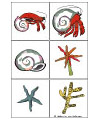
Hermit Crab
Concentration Game
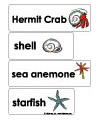
Hermit Crab
Word Wall
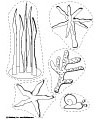
Hermit Crab
Puppets

Poem

Hermit Crab
by Sandra Liatsos
I watch him scurry on the sand
To find a house that's second-hand.
He crawls in someone else's shell
And stays because it fits him well.
Imagine if we did the same,
Just barged right in and staked a claim
To any empty house that fit,
Then settled down to live in it.
The Months of the Year
(Tune: Three Blind Mice)
January, February, March,
April, May, June.
July, August, September,
October, November, December.
These are the twelve months of the year.
Now sing them together so we can all hear.
How many months are there in a year?
Twelve months in a year.
End-of-School-Related Books
Biscuit's Graduation Day by Alyssa Satin Capucilli
It's Graduation Day by Grace Maccarone
Happy Graduation by Margaret McNamara
Summer's Vacation by Lynn Plourde
Last Day Hooray by Nancy Poydar
Miss Bindergarten Celebrates the Last Day of Kindergarten by Joseph Slate
Happy Graduation by Namrata Tripathi
The Night Before Summer Camp by Natasha Wing





